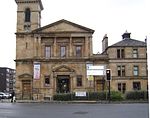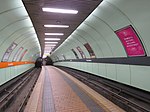The National is a Scottish daily newspaper owned by Newsquest. It began publication on 24 November 2014, and was the first daily newspaper in Scotland to support Scottish independence. Launched as a response to calls from Newsquest's readership for a pro-independence paper in the wake of the 2014 Scottish independence referendum, it is a sister paper of The Herald, and is edited by Callum Baird. Initially published on weekdays, a Saturday edition was added in May 2015. The National is printed in tabloid format, and is also available via online subscription.
Details of its launch were announced on 21 November, with further information given at a Scottish National Party (SNP) rally the following day. It was launched on a five-day trial basis against the backdrop of a general decline in newspaper sales, with an initial print-run of 60,000 copies for its first edition, but this was increased the following day as a result of public demand, and Newsquest decided to print it on a permanent basis after healthy sales continued throughout the first week. The first front page carried a story about charities urging devolution of powers over welfare legislation to Scotland.
Reception to the newspaper's launch was mixed in both media and political circles. Libby Brooks of The Guardian noted that its international coverage was strong but that its news was "central belt-centric – and Holyrood-filtered", while the Labour peer George Foulkes branded it "McPravda". However, the Scottish journalist and broadcaster Lesley Riddoch – who went on to write for the title – was more positive, claiming its launch could be a "sound business move" by its publishers. Upon its launch, The National stated that it is a separate entity from the SNP.
By January 2015, daily sales had fallen to below 20,000. The following year, its print edition dropped below 10,000, and was being outsold by every Scottish regional daily newspaper with the exception of the Paisley Daily Express.The Sunday National was launched as a Sunday edition on 9 September 2018 as a replacement to its former sister title the Sunday Herald.








